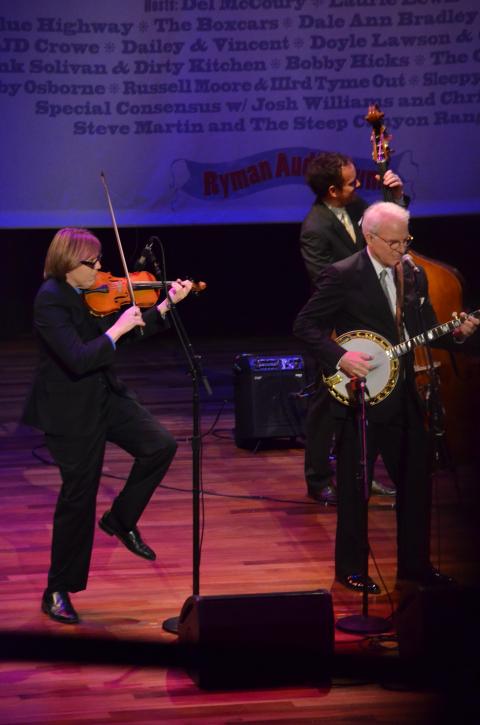Nicky Sanders '02

The Grammy-winning SCR band, featuring fiddler Nicky Sanders ’02, does about 150 gigs a year across the country, and Martin appears with SCR about a third of the time. Martin gave Sanders a shout-out in the liner notes to Rare Bird Alert, the 2011 album on which Martin and SRC collaborated. “Nicky Sanders is the Rangers’ astounding fiddle player, and when he steals the show onstage, I have to work extra hard to steal it back from him,” Martin wrote. That compensates for the ribbing Martin gives him onstage.
Sanders joined SCR nine years ago, and in 2009 Martin jumped into the mix. “This side gig as Steve’s backing band has made our work so much more interesting and complex,” Sanders says. “In 2004 we were playing dive bars all over the country, just scraping by, doing it for the love of the music. No one ever expected things would get to the point where our own album would win a Grammy or that we’d work with Steve Martin.”
Connecting
The Martin connection began with Anne Stringfield, whom Martin married in 2007. Stringfield’s family and SCR lead singer Woody Platt met years before during the Stringfield’s summer vacations in North Carolina. Platt took them on fly-fishing expeditions. In 2009, after Martin released his debut banjo album The Crow, he sought a touring band. Stringfield orchestrated a meeting between Martin and the Steep Canyon Rangers during another North Carolina vacation. “We’d bought the CD and learned Steve’s tunes hoping someday we’d have a chance to meet him and play with him,” Sanders says. The effort paid off. After dinner and beers on the porch, Martin and the band jammed and became musical compadres.
“Later, we had a gig at Joe’s Place in New York and invited Steve and Anne to come out,” Sanders says. “Steve sat in on ‘The Crow.’ Backstage he said playing that song had never felt better to him. A few weeks later, we got a call from his agent saying Steve wanted to do a world tour with us. We were floored!”
In concert, it’s immediately apparent that many musical styles inform Sanders’s virtuosity. His impeccable intonation—especially in the double- and triple-stopped chords—betrays his years of classical training and working up J.S. Bach’s unaccompanied violin sonatas and partitas. But his fluid, rhythmically sure lines and the aggressive bite of his bow on up-tempo hoedown numbers testify that he has played lots of jazz as well as bluegrass.
Sanders truly shone on the show’s barn-burning finale “Auden’s Train.” His solo traversed a few musical styles and quoted “Orange Blossom Special,” songs by the Beatles, the Beach Boys, and Queen, the theme from The Simpsons, and classical melodies by Khachaturian and Rossini. It brought the show to a climactic finish.
Sanders grew up in the San Francisco Bay Area and started playing classical violin at the age of five. He was the concertmaster of his youth orchestra and won a concerto competition before receiving a scholarship to Berklee, where his musical horizons broadened. “I started as a composition major studying Beethoven’s string quartets and atonal composition as well as classical violin with Sandra Kott,” he says. “Berklee allowed me to diversify and I took jazz violin lessons with Matt Glaser.” Later, Sanders got into gritty fiddle music after a friend gave him a mix CD of new acoustic music featuring Béla Fleck (banjo), Sam Bush (mandolin), and Stuart Duncan (fiddle). Sanders began spending hours in Berklee’s Media Center exploring new acoustic music and ultimately decided to pursue bluegrass.
He sat in on weekly bluegrass jams at the Cantab Lounge in Cambridge and played gigs in a variety of styles after Berklee. “A friend I’d met at the Cantab named Tony Watt recommended that I audition for Steep Canyon Rangers, who were in Asheville, North Carolina,” Sanders recalls. “Tony said Asheville would be a good place for me to go if I was serious about playing bluegrass.”
By that time, in 2004, SCR had two recordings out and was in between fiddle players. Sanders sent MP3s of him playing three bluegrass tunes and one of his classical compositions. It caught the ear of SCR mandolinist Mike Guggino, and Sanders trekked to Asheville for an audition. “I packed up my Oldsmobile Cutlass—an old beater of a car—and drove down there and never left,” Sanders says. After a few months of subbing with the group, he was offered the fiddle chair.
SCR has to keep the music for their shows as well as Martin’s under their fingers. The gigs with Martin are at upscale venues such as the White House or Radio City Music Hall, and with orchestras in symphony halls across the nation. SCR’s own concerts take them to various auditoriums, colleges, and bluegrass festivals.
Their shows and records feature their multifaceted original tunes in a progressive bluegrass style. The Nobody Knows You CD—a Grammy winner in February for Best Bluegrass Album—accurately represents the band’s current musical leanings. “For a time, we felt we had to play a certain way to be accepted in the bluegrass community,” Sanders says. “Now we just play good music without trying to fit a mold. The music takes us out of the box and into the ether. We’re riding a big wave these days and that’s extremely exciting. Nobody knows where it’s taking us.”




